So, your employer is making long-term capital improvement plans, and it should be a terrific opportunity to incorporate low-impact development (LID) principles from the ground up. But not everyone’s on board, and some of their objections must be dealt with. Here are some common objections to sustainable development—and how you can overcome them.
‘It Costs Too Much’
The installation costs for green infrastructure can cost more up front than traditional infrastructure. Take, as an example, low-impact stormwater practices. The cost of purchasing plant material; of site preparation, soil amendments, underdrains, and connections to municipal stormwater systems; and increased project management costs can indeed mean that the initial cost of the system exceeds that of traditional development methods. But that doesn’t mean they’re a bad investment. The initial investment can be recouped—in some instances, very quickly.
Offsets include:
- Reduced land use for stormwater retention. When you don’t have to build a stormwater retention pond, that land becomes available for other uses—some housing developments have gained two lots from the practice.
- Reduced maintenance costs. The cost of maintaining a retention pond—removing trash, sediment, and vegetation—are often much higher than the cost of maintaining low-impact stormwater management practices, like bioretention areas and swales, because these are covered by ordinary landscape maintenance costs.
- Reduced regulatory costs. In areas where stormwater mitigation costs are high, LID and stormwater management practices can sometimes avoid those costs.
‘It Won’t Hold Up’
The durability of nontraditional materials and structures can be difficult to predict; they don’t have the track record of older materials. Is there a chance you could spend the extra money to put them in place, only to end up replacing them that much sooner?
This is less of a concern than it was, say, 20 years ago. Today, organizations like the Landscape Architecture Foundation have aggregated the results of pilot projects, demonstrations, and fully-implemented projects to provide performance information specific to project type, climate, size, and budget. Many technologies that were once experimental are steadily working their way into the category of tried and true.
‘It Violates Water Rights Laws’
In some areas—particularly the drier areas of the western United States—water use is extensively regulated, and green development practices can fall foul of those laws. But not always; it’s important to know the law in your state and in your local area. Does the state have jurisdiction over precipitation? If so, some green infrastructure practices may violate the law. But even in states that exercise jurisdiction over precipitation, projects might be permitted with design modification or special permits.
It is also possible that a state or municipality encourages some types of green infrastructure projects; check with local agencies to see what kinds of projects they support.

